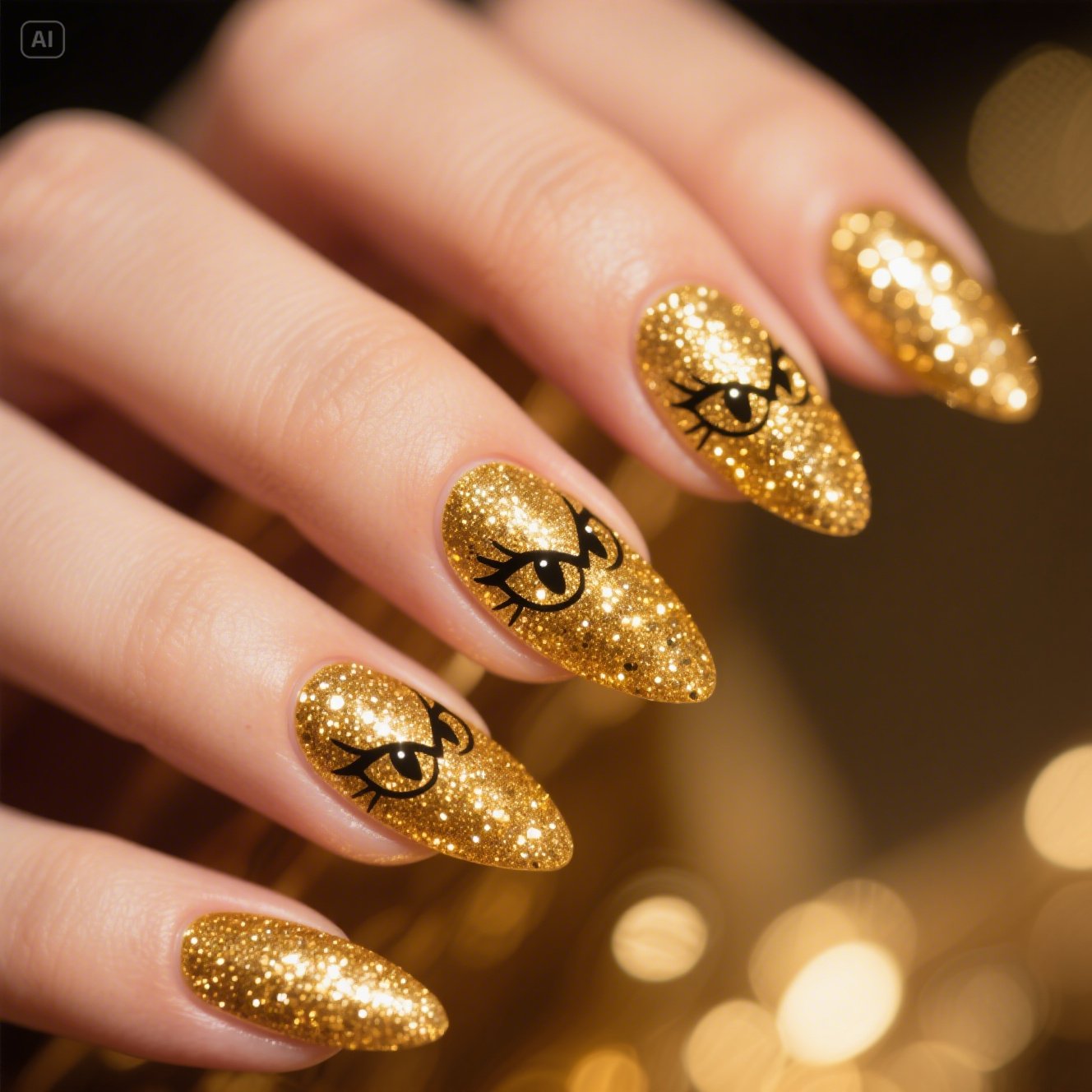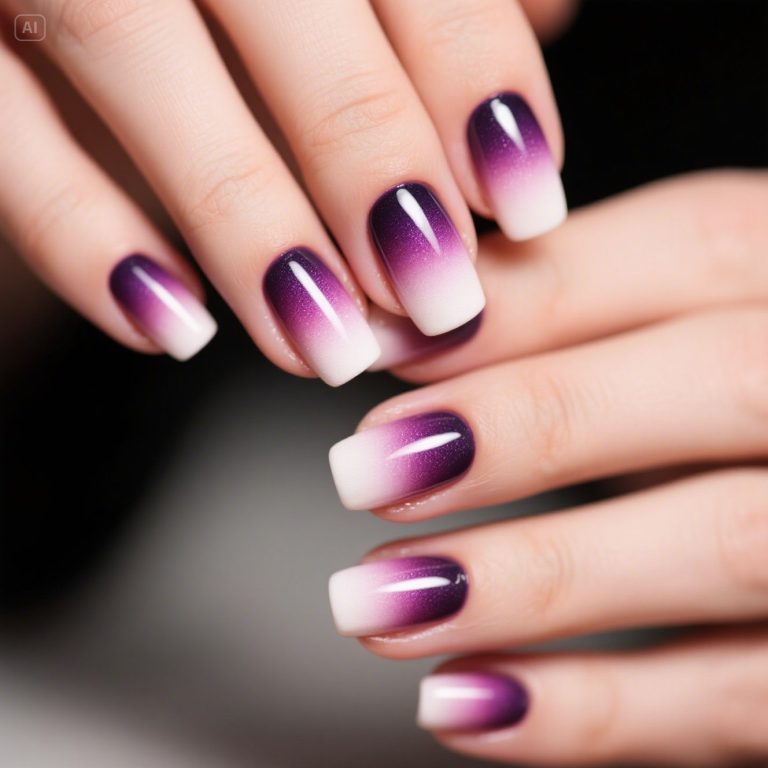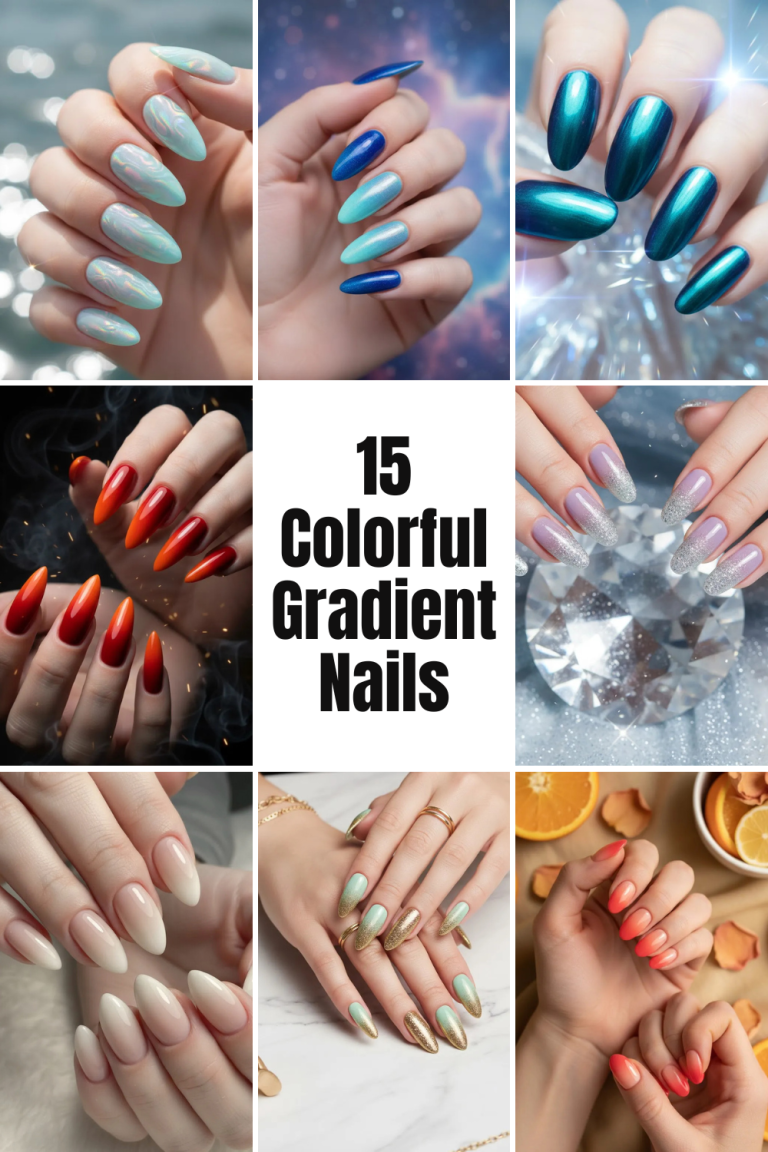15 Gorgeous Wall Mirror Decoration Ideas to Brighten Any Room
Why Mirrors Instantly Brighten a Space
Wall Mirror are like sunshine multipliers. They bounce the light you already have—sunlight by day, lamps by night—so the room looks brighter without adding more fixtures. The trick is simple physics: reflective surfaces push light around, softening shadows and lifting dark corners. This makes a room feel lively and welcoming, especially if you’re dealing with small windows, a north-facing space, or a room that just feels a bit flat. With smart placement, a mirror can shift the mood from dull to glowing in minutes, and that gives you a big style win for little effort or cost.
The Light-Bounce Effect Explained
Imagine tossing a tennis ball at a wall: it ricochets back. Light acts the same way when it hits a mirror. If the mirror faces a window or a lamp, it reflects that light across the room, doubling the perception of brightness. Place the Wall Mirror at an angle that catches daylight for most of the day, and you’ll notice fewer dark patches and a more even glow. This bounce effect doesn’t make the room brighter in a scientific sense, but to our eyes, it absolutely does. Aim to reflect the lighter parts of your room—windows, white walls, warm lamps—for the best results.
Visual Space & Depth—Making Rooms Feel Larger
Mirrors also trick the eye into seeing depth. A well-placed Wall Mirror can make a compact living room feel wider or a short hallway feel longer. This happens because the reflection adds a “view” where a wall would normally end. Think of it as borrowing space from another world—your room’s mirror world. If your room feels cramped, try a large mirror near the narrowest wall. Even better, place it where it reflects open space, like a doorway or window. The outcome is a room that breathes, looks lighter, and simply feels better to spend time in.
How to Choose the Right Mirror for Each Room
Choosing the right Wall Mirror is like picking the right shoes for an outfit—shape, size, and style matter. Large mirrors help small rooms; smaller mirrors add sparkle without taking over. Frames add attitude: wood warms things up, metal feels modern, rattan brings boho charm. Match your mirror’s style to your decors, but don’t be afraid to mix it up for contrast. A sleek black-framed mirror in a traditional room can feel delightfully fresh. Also, measure twice; mirrors look smaller in stores than on your wall. Mark the wall with painter’s tape to preview the footprint before buying.
Shape, Size, and Frame Style Basics
Round mirrors soften sharp rooms full of straight lines. Rectangular mirrors feel tailored and traditional. Arch-top mirrors lend a romantic or classic vibe. Oversized mirrors shout “statement,” while small ones whisper “polish.” As for frames, chunky wood frames feel cozy, thin metal frames lean minimalist, and antique-gold frames add elegance. If your space already has lots of patterns, choose a simpler frame to keep things calm. If your room needs personality, pick a bold frame to boost character. Always think balance: if furniture is heavy, a slimmer mirror frame can keep the look airy.
Matching Mirrors to Your Decor Theme
Modern interiors pair well with frameless or thin black- or brass-framed mirrors. Farmhouse or rustic rooms love distressed wood frames. Coastal spaces shine with whitewashed or rope-wrapped frames. Glam rooms sparkle with bevelled edges and metallic finishes. Boho looks love rattan, bamboo, and organic shapes. When in doubt, repeat a finish you already have, like matching your Wall Mirror frame to your cabinet pulls or light fixtures. This little echo ties the room together without feeling too matchy-matchy. The goal is harmony: your mirror should feel like it belongs, yet still brings a special touch.
The 15 Mirror Ideas
1) Oversized Statement Mirror Above a Sofa or Sideboard
Go big to get big impact. An oversized Wall Mirror above a sofa or sideboard acts like a window you installed without the construction bill. It catches and spreads light, adds height, and makes the wall feel important. Choose a width that’s slightly narrower than the furniture below so it looks balanced. A thin black or brass frame gives a modern edge; a carved wood frame brings warmth. If your room lacks artwork, a large mirror fills that role while keeping things light. Bonus: it’s a great backdrop for plants and candles, which will double in the reflection.

2) Gallery Wall of Mixed Small Mirrors
A gallery wall doesn’t have to be only art prints. Mix small mirrors of different shapes—round, oval, arched, even a quirky sunburst or two—into a fun, lively arrangement. This approach is perfect for renters or anyone who likes to change things often. Try a loose grid or a natural, clustered layout. Keep some consistency—maybe all frames in a single finish—to avoid visual chaos. The effect is playful and bright, like a constellation of sparkle across your wall. It’s also a great way to use vintage finds from flea markets without matching sets.

3) Round Mirror Over a Console Table
The round-over-console combo is a timeless decorator favorite. The circle softens the straight lines of the console and the wall, creating a balanced vignette. Style the tabletop with a lamp, a tray, and a small plant to frame the Wall Mirror without hiding it. A round mirror in an entryway is especially helpful: last-minute hair check, anyone? Choose a mirror roughly two-thirds the width of your console to keep proportions sweet. If your console has drawers or baskets, the round mirror prevents the area from looking too boxy and stiff.

4) Sunburst Mirror as a Focal Point
A sunburst mirror brings pure joy to a room. With its radiating “rays,” it adds movement and a hint of glam. Hang it above a mantel, bed, or dining console where it can take center stage. The style suits both mid-century and modern spaces, depending on the finish—gold for glam, wood for organic warmth, black for edge. Keep surrounding decor simple so the sunburst can shine. At the right spot, the Wall Mirror will bounce light outward like its namesake, and the rays will animate the wall with a sculptural effect.
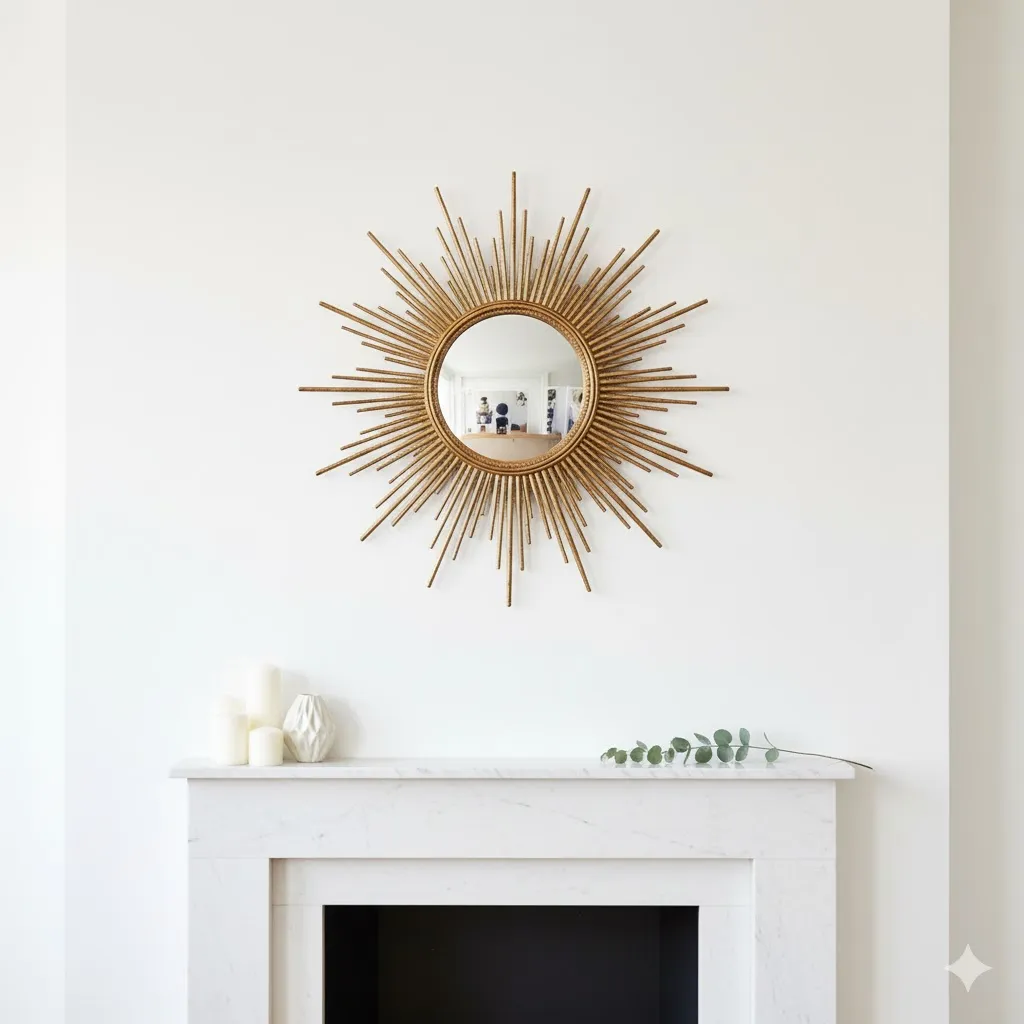
5) Leaning Floor Mirror for Casual Chic
Leaning a mirror against the wall adds an easy, lived-in feel. It’s ideal for bedrooms and dressing areas because you get a full-length view without drilling into the wall. Look for a sturdy frame and consider anti-tip hardware for safety, especially if you have kids or pets. Position the Wall Mirror where it catches daylight to brighten the floor area—this can make low rooms feel taller. A rustic wood frame leans cozy, while a sleek metal frame leans modern. Slide a basket or pouf nearby to finish the relaxed, boutique-dressing-room vibe.

6) Windowpane Mirrors to Fake Natural Light
Windowpane mirrors look like real windows thanks to their grid of mullions. Hang one on a wall that faces a window to “double” the view, or place it on a dark wall to mimic a window where there is none. This trick is powerful in basements, rental apartments, or rooms with only one small window. Choose black or bronze grids for an industrial look, or white for a cottage feel. Keep the surrounding wall simple so the faux-window illusion holds. Plants nearby will reflect in the panes and make the “view” feel convincing.
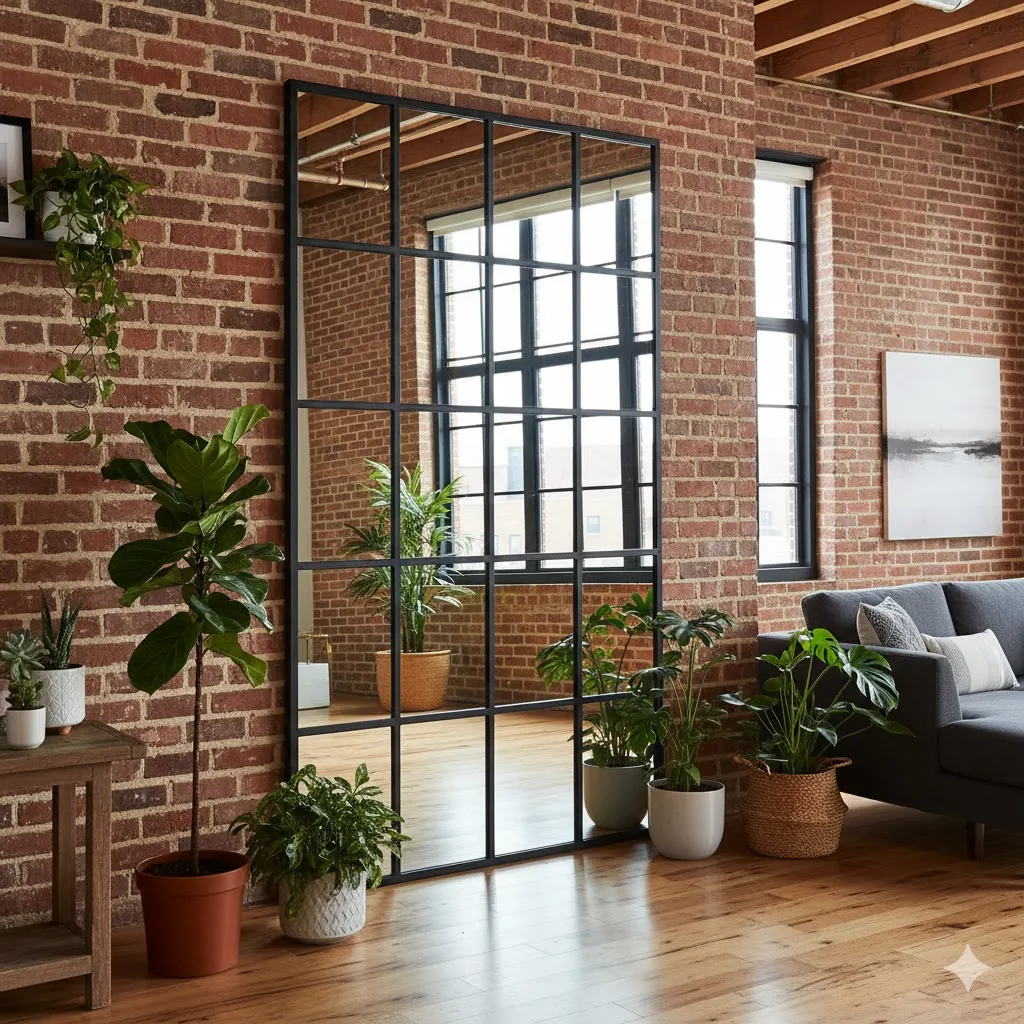
7) Mirror Over the Fireplace Mantel
A mantel mirror is classic for a reason: it lifts the room’s center of gravity and makes the whole space feel taller. Choose a shape that complements your fireplace—arched for soft elegance, rectangle for a clean, tailored look. Keep the frame proportional to the mantel width. Style sparingly: a pair of candlesticks, a small vase, and maybe a framed photo. If you have a TV over the fireplace, consider a Wall Mirror on a side wall instead to avoid visual competition. The goal is a calm focal point that brightens your seating area.
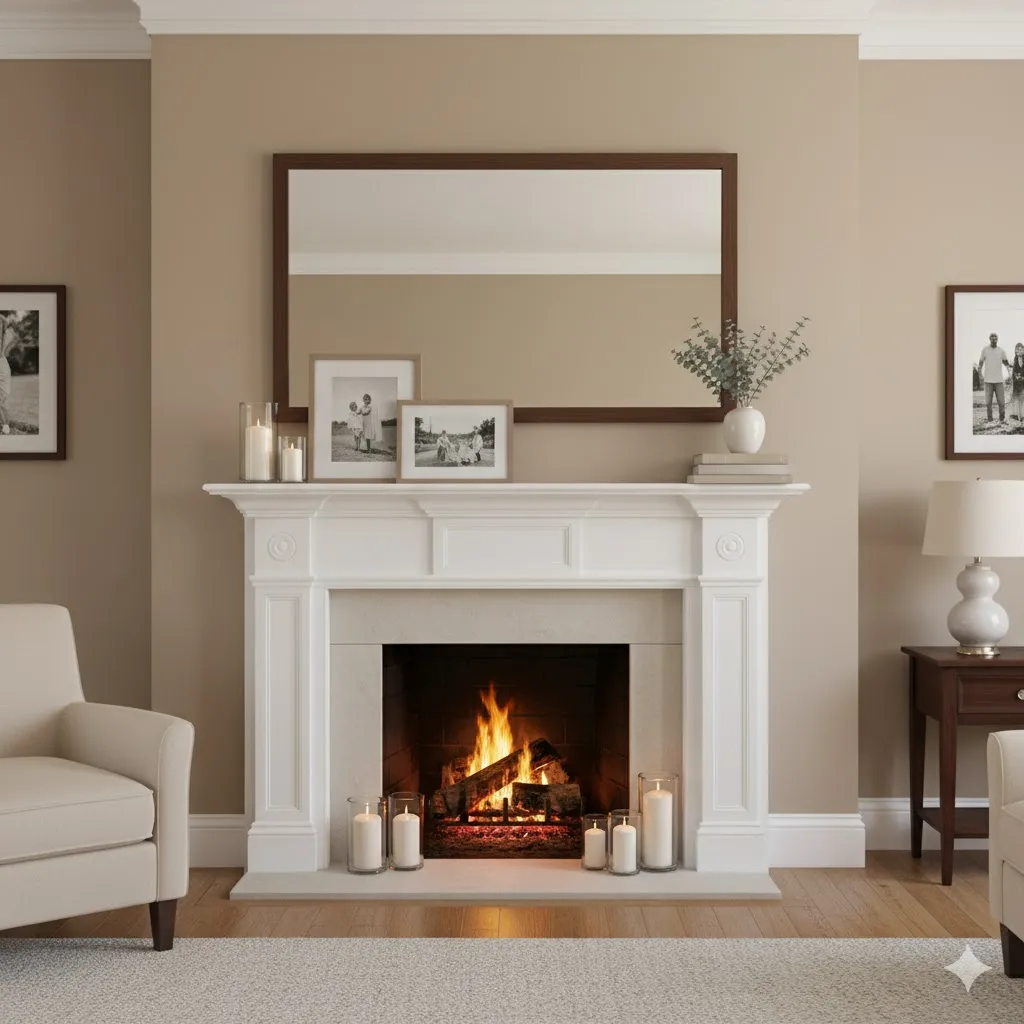
8) Double Mirrors in the Bathroom
Two mirrors over a double vanity feel crisp and hotel-chic. They also reflect more light than a single wide mirror, and they frame each sink as its own moment. Pair them with wall sconces on the sides for flattering, shadow-free light. Round or arched mirrors soften the hard lines of tile and cabinetry, while rectangle Wall Mirror keep things minimal and neat. If your bathroom is small, choose mirrors with slim frames to keep the look airy. The reflections also make tile patterns and textures feel richer without overwhelming the space.

9) Entryway Mirror with Shelf or Hooks
The entry is your home’s handshake, and a Wall Mirror here is both useful and brightening. Look for designs that include a small shelf for keys and mail or hooks for bags and hats. This turns a simple mirror into a hardworking station. Place it opposite or next to your doorway light so it bounces illumination into the hall. For tight foyers, choose a taller, narrower mirror to stretch the space. Add a small rug and a plant, and you’ve created a welcoming spot that feels organized, open, and friendly the second you step in.
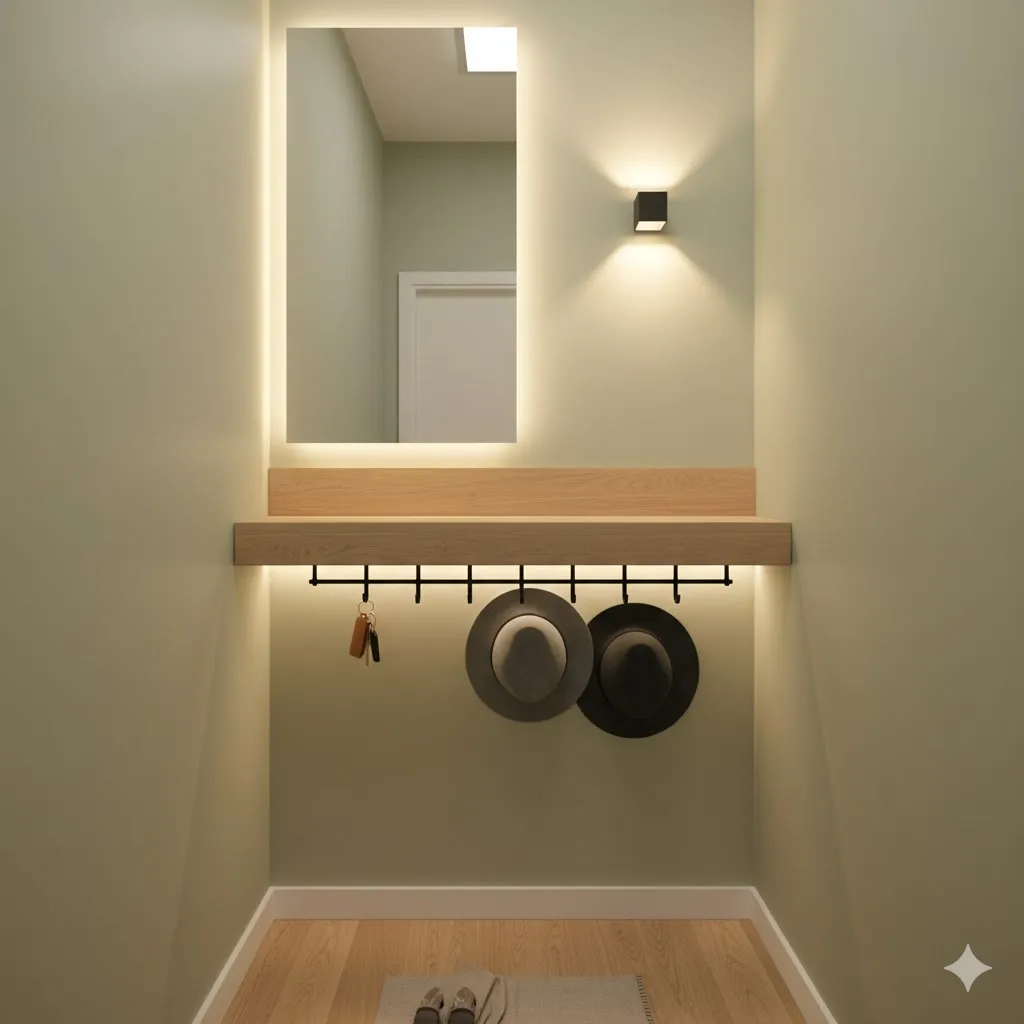
10) Dining Room Mirror Opposite a Window
A dining room mirror does more than reflect the table—it doubles the glow of candles and pendant lights for a warm, festive feel. Hang it on the wall opposite a window to pull in daylight, or across from a hutch to reflect pretty dishes and glassware. Keep glare in mind: angle the Wall Mirror slightly if it catches harsh midday sun. A larger rectangular mirror reads formal; a pair of smaller mirrors feels modern and graphic. When dinner starts, the reflections make the room look lively and the table setting look extra special.
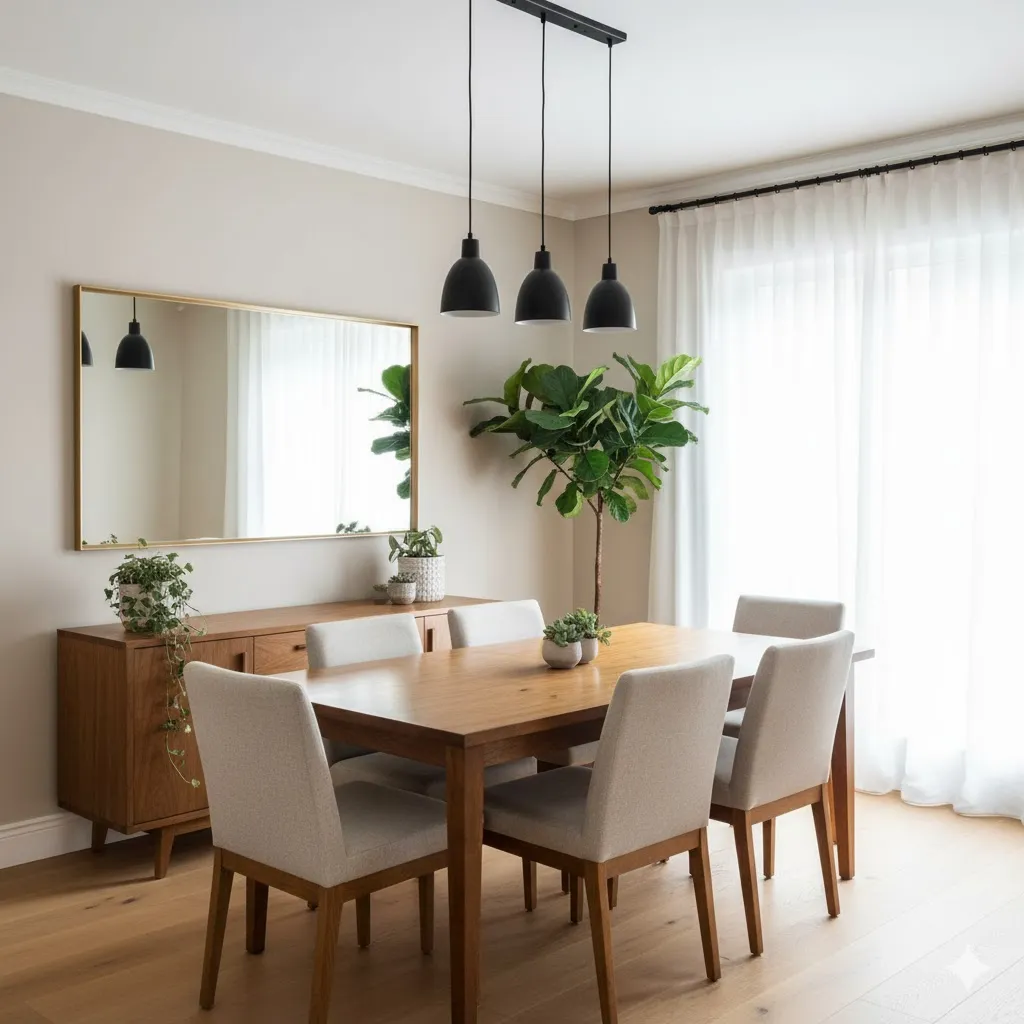
11) Vanity Mirror with Soft Lighting in the Bedroom
Your bedroom vanity deserves a mirror that makes you feel good. Choose a Wall Mirror that’s at least the width of the vanity and pair it with soft, warm lights—string lights, globe bulbs, or sconces that sit at face height. This setup creates an even, flattering glow with fewer harsh shadows. A framed mirror adds decor value, while a frameless, bevelled design leans elegant and quiet. Keep the surface tidy: a tray for daily items, a small vase, and a compact mirror for close-up tasks. The reflection will make the corner feel like a cozy retreat.
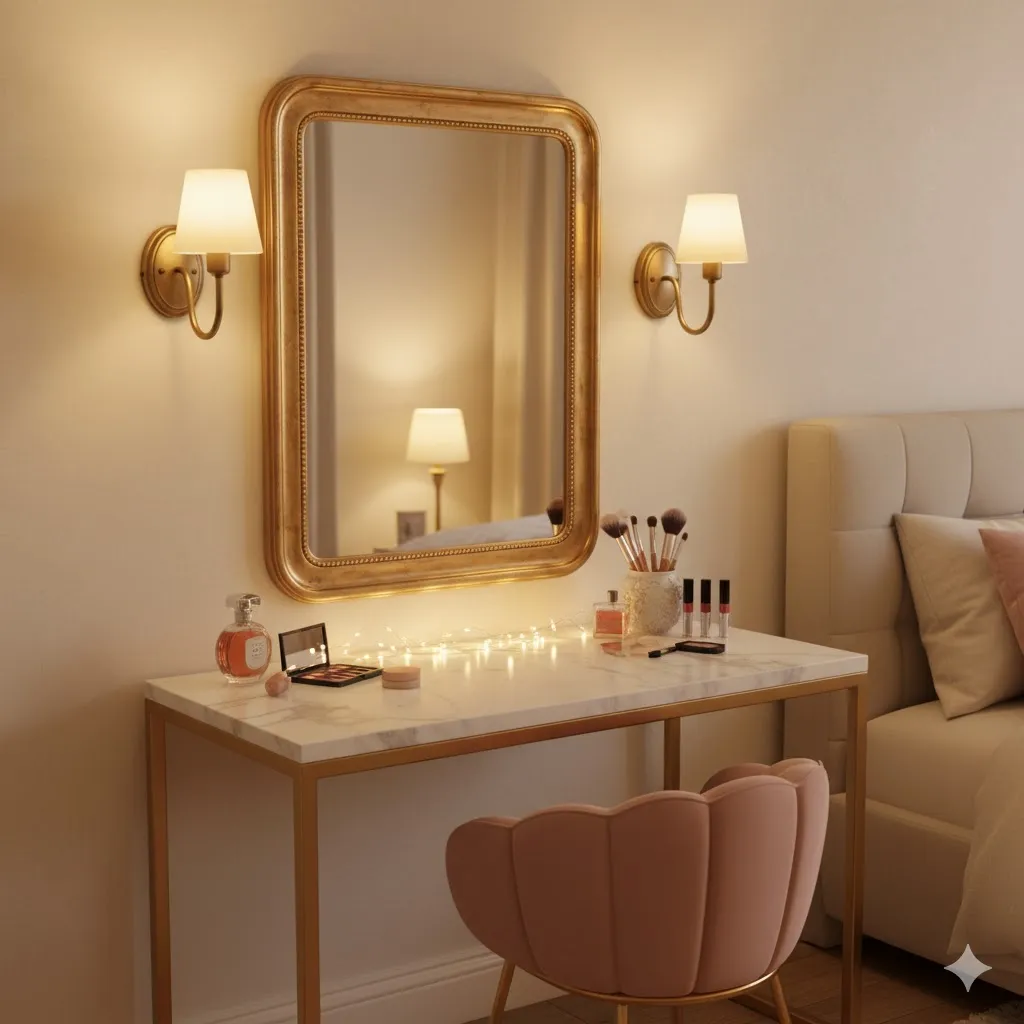
12) Mirrored Panels or Tiles as an Accent
If you love drama, try mirrored panels or tiles on one accent area—behind a bar cart, inside a bookcase, or on a small feature wall. This approach turns functional reflection into texture and pattern. Antique or smoked mirror tiles add depth without blinding shine, while clear Wall Mirror tiles deliver maximum brightness. Use them in moderation for sophistication. Panels are great for renters if you choose peel-and-stick options. Keep nearby decor simpler so the sparkle doesn’t compete with everything else. The result is a luxe, light-catching surface that looks custom without the custom price.
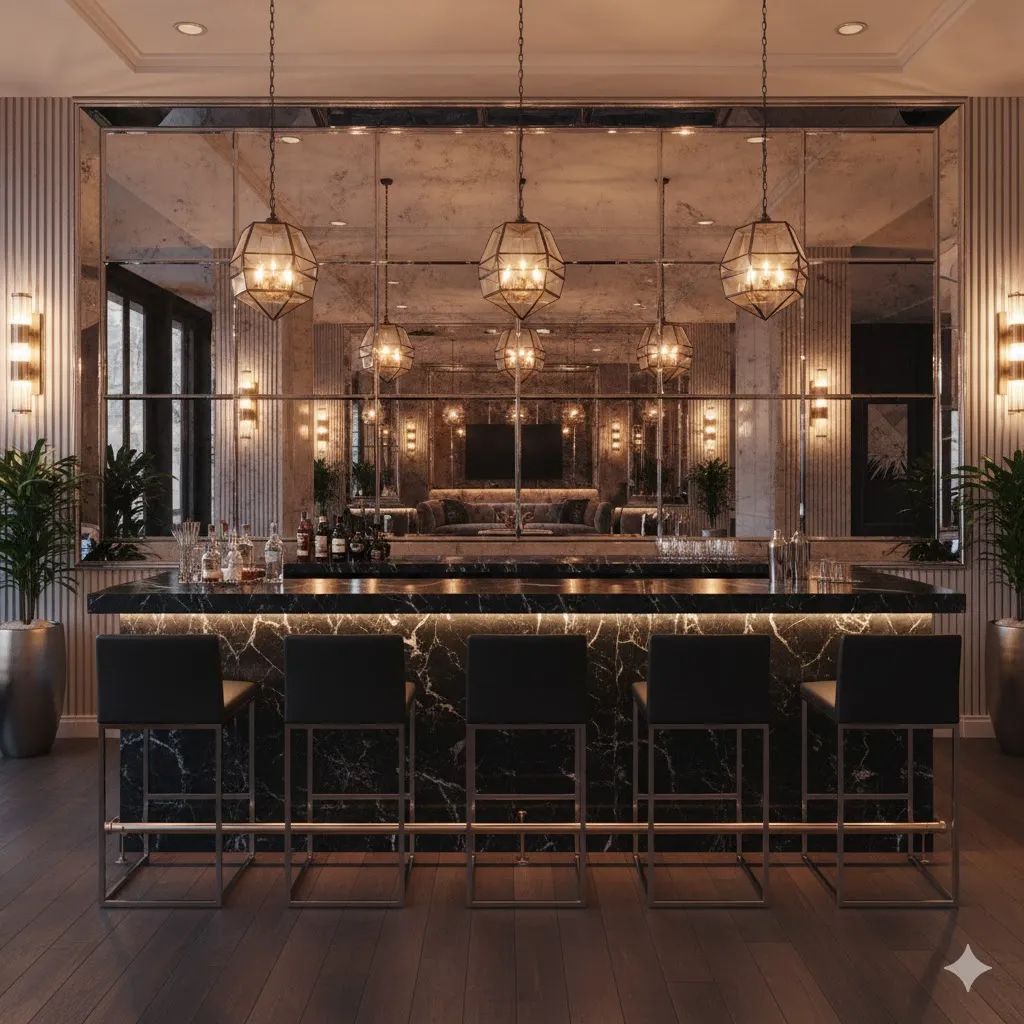
13) Narrow Hallway Mirror to Stretch the View
Hallways can feel like tunnels. A tall, slim mirror placed near the end of a hallway “opens” the route and guides the eye forward. If you have space, add a pair of wall sconces flanking the Wall Mirror so the light bounces along the corridor. For very tight hallways, choose a frameless design to keep things sleek and avoid snags. Another trick: hang a series of small identical mirrors at equal spacing to create rhythm and a sense of motion. The reflection creates a subtle illusion of width and makes the pass-through feel considered.
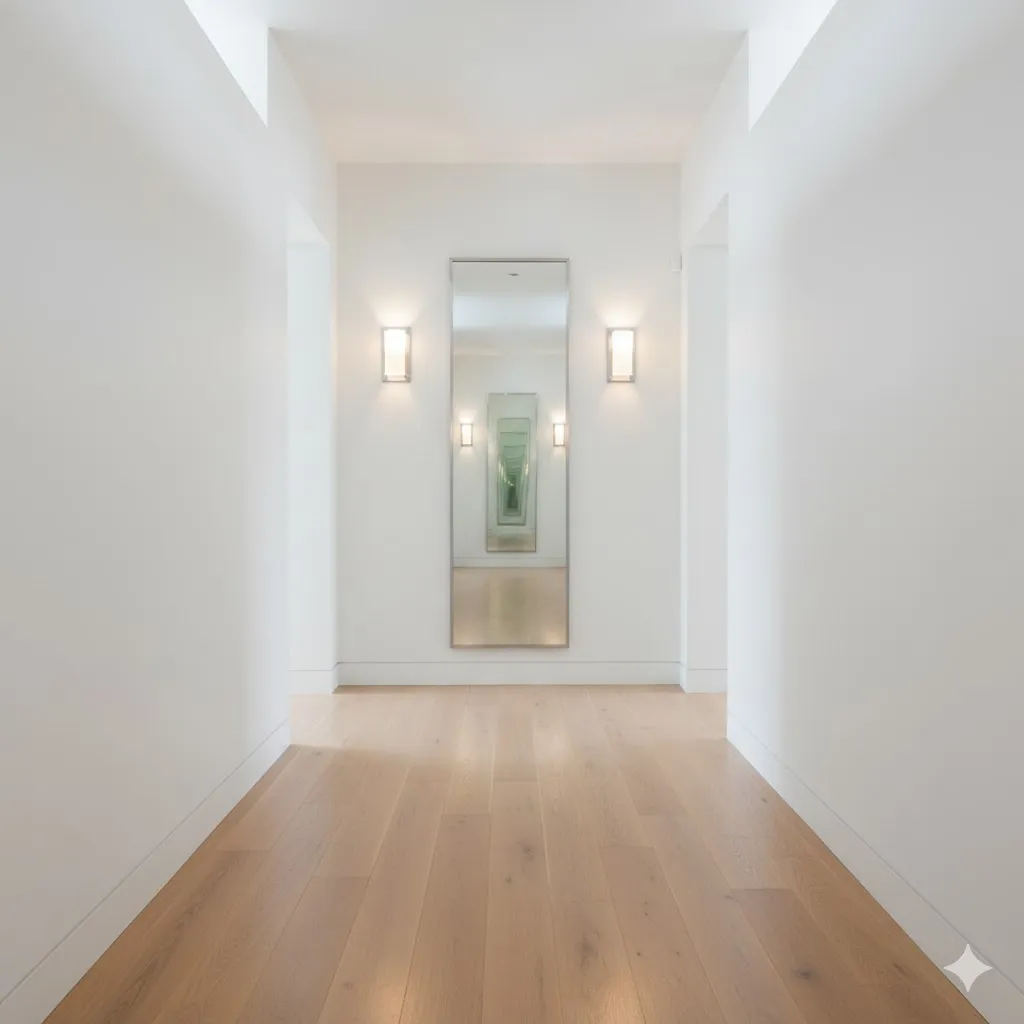
14) Kitchen Backsplash or Niche with Mirror
A mirrored backsplash is bold and bright, especially in small kitchens where every ray of light counts. It reflects under-cabinet lighting and makes counters feel longer. If a full backsplash feels too much, try a mirrored panel in a coffee niche or behind open shelves. Choose antiqued mirror finishes to hide splashes and fingerprints better than clear mirror. Keep in mind safety and cleaning: use materials made for kitchens and seal edges well. The payoff is a kitchen that sparkles even on cloudy days and feels bigger without knocking down walls.

15) Outdoor-Safe Mirror for Patio or Balcony
Yes, you can use Wall Mirror outdoors—just pick weather-resistant designs. An outdoor-safe mirror on a patio wall reflects greenery and sky, making small balconies feel lush. Place it where it won’t reflect harsh sun directly into neighbors’ windows (or your eyes). A windowpane style works beautifully outside, blending with vines and planters. Use appropriate anchors for brick or stucco and check the manufacturer’s guidance for outdoor use. The effect is magical at dusk: string lights and lanterns multiply in the reflection, turning a simple seating corner into an inviting evening scene.

Placement, Height & Safety Tips
Good placement is half the magic. As a rule of thumb, hang the mirror’s center around eye level—about 57–60 inches from the floor—so it feels natural for most people. Over furniture, leave 6–8 inches between the top of the piece and the bottom of the Wall Mirror to keep things visually connected. Always check the weight of your mirror and the wall type. Use studs when possible; if not, use proper wall anchors rated for the weight. In kids’ rooms or busy halls, consider security clips or safety film. Safety first, style right after.
Eye-Level Rules of Thumb
Eye level is a guideline, not a law. In rooms where you’re mostly seated—like dining rooms—hang a bit lower so the reflection serves the seated view. Over a mantel, aim to keep the visual “stack” balanced: firebox, mantel, then Wall Mirror. If your ceilings are high, you can go slightly higher to celebrate that height. Before drilling, trace the mirror on paper, tape it up, and live with it for a day. This simple test saves extra holes and second guessing.
Proper Anchors, Studs, and Weight Ratings
Mirrors are heavier than they look. Check the back hardware—D-rings, wire, or French cleat—and pick anchors to match. On drywall, toggle bolts or heavy-duty anchors are your friends when a stud isn’t available. For brick or concrete, use masonry anchors. If you’re leaning a floor mirror, add anti-tip brackets for peace of mind. The goal is not just to hang the Wall Mirror, but to hang it safely for years, so you can enjoy the brightening benefits without worry.
Lighting Pairings That Maximize Mirrors
Mirrors and lighting are best friends. A mirror near a lamp spreads a soft pool of light, which feels cozy and upscale. Sconces flanking a mirror create even illumination for grooming or makeup. In living rooms, angle mirrors to capture daylight from windows during the day, then let them reflect warm lamp light at night. Avoid placing a Wall Mirror directly opposite a very bright bare bulb—that can cause glare. Instead, aim for reflected glow, not direct glare. Layer your lighting—ambient, task, accent—and your mirror will multiply the effect.
Sconces, Pendants, and Natural Light
Flank bathroom mirrors with sconces at about eye level to reduce shadows. Over dining mirrors, pendants or chandeliers reflected in the glass add drama without extra fixtures. In bedrooms, a pair of small pendants reflected in a Wall Mirror can make the room feel hotel-polished. During the day, let natural light do the heavy lifting: mirrors opposite or diagonal to windows pull brightness deeper into the space. Use sheer curtains to soften the light so the reflection stays gentle and flattering.
Budget & DIY Mirror Upgrades
You don’t need a designer budget to create designer impact. Thrift stores are full of mirrors waiting for a little love. A quick frame paint job—matte black, warm brass, or soft white—can transform a dated piece. Peel-and-stick mirror tiles create custom patterns on a budget. You can even layer a small mirror on top of a larger framed art print for a playful, one-of-a-kind look. For renters, Command strips or leaners are your best friends. The fun of Wall Mirror is that even small, cheap changes can make a space feel brighter and more styled.
Paint, Peel-and-Stick, and Thrift Flips
Spray paint makes frame makeovers fast; just clean, lightly sand, and tape off the glass first. For ornate frames, rub-and-buff metallic wax adds a luxe touch. Peel-and-stick mirror tiles are great for backsplashes or inside bookcases—lay out your grid on the floor before installing. When thrifting, look for quality glass and solid frames; minor scratches on frames are easy to fix. Adding picture-frame moulding around an inexpensive Wall Mirror can also create a custom, built-in effect for less.
Cleaning & Care for Crystal-Clear Mirrors
Smudges kill the sparkle. For a streak-free clean, spray glass cleaner onto a microfiber cloth (not directly on the Wall Mirror) to avoid drips. Wipe in an S-pattern from top to bottom. For stubborn spots, a 50/50 mix of water and vinegar works wonders. Avoid ammonia near antique frames or special finishes. Don’t forget the edges—moisture trapped there can cause blackening over time. Keep a small cloth in the vanity drawer and give high-touch mirrors a quick daily wipe. Clean mirrors reflect more light—literally the brightest upgrade you can make.
Streak-Free Methods and What to Avoid
Paper towels can shed lint; microfiber is better. Newspaper can work in a pinch but may leave ink. Skip abrasive pads that scratch coatings. If your Wall Mirror has bevelled edges, dry them well after cleaning to prevent buildup. In kitchens, de-grease first with a mild dish soap solution, then finish with glass cleaner. A little routine care keeps your mirror looking like new and your room feeling fresh.
Common Mistakes to Skip
It’s easy to overdo mirrors. Too many can make a room feel busy. Aim for one strong focal mirror or a cohesive group, not both. Watch out for awkward reflections—no one wants to see the cluttered laundry pile doubled. Avoid placing Wall Mirror where they’ll reflect harsh sun directly into eyes or screens. In tiny rooms, a mirror that’s too small looks fussy; go larger than you think. Lastly, don’t hang heavy mirrors with flimsy hardware. The right placement and anchoring keep your space bright and your mind calm.
Overclutter, Glare, and Awkward Angles
Keep your sightlines in mind. Sit on the sofa and check what the Wall Mirror captures. Stand at the entry and see what greets you. If glare is an issue, shift the angle or add sheer curtains. When in doubt, simplify: one well-chosen mirror can do more than five small ones. Thoughtful editing ensures your mirrors enhance, not overwhelm.
Conclusion
Mirrors are the easiest design tool for instant brightness and a bigger-feeling room. By understanding how they bounce light and create depth, you can choose the right shapes, sizes, and frames for every space. From oversized statements to clever gallery walls and outdoor-safe options, these 15 ideas prove that Wall Mirror do more than show your reflection—they transform how your home feels. Place them smartly, pair them with good lighting, hang them safely, and keep them clean. Your reward is a home that looks lighter, livelier, and more welcoming every day.
FAQs
1) What size mirror should I choose for above my sofa?
Pick a mirror that’s about two-thirds the width of your sofa for balanced proportions. If your room is small, go a little bigger—large Wall Mirror make small rooms feel more open and bright.
2) How high should I hang a mirror?
A good guideline is to center the Wall Mirror around 57–60 inches from the floor. Over furniture, leave 6–8 inches between the top of the piece and the bottom of the mirror to keep the arrangement visually connected.
3) Will a mirror opposite a window always help?
Usually yes, because it bounces daylight deeper into the room. Just watch for glare and heat. If it’s too bright, angle the Wall Mirror slightly or use sheer curtains to soften the light.
4) Are mirrored backsplashes practical in kitchens?
They can be, especially in small or dark kitchens. Choose antiqued or smoked finishes to hide splashes better, and use materials rated for kitchen use. Clean regularly with a non-abrasive method.
5) Can I use mirrors outdoors?
Yes—look for Wall Mirror designed for outdoor use with weather-resistant frames and backing. Place them where they reflect greenery or string lights and avoid directing glare into neighbors’ windows.

